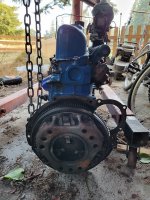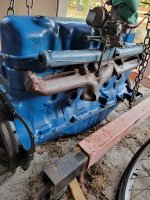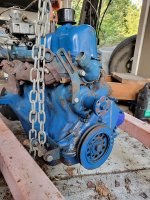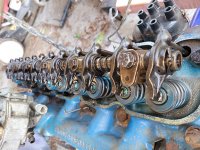Hello folks -
While I have still not actually towed the "free 1962 Ranchero" to my house, (though I did hear it run for the first time in years) I did manage to acquire a 200 inline 6 from a 1965 Mustang to replace the reportedly tired 170. [If you want to just skip to the actual questions, free free to jump a paragraph ;-) ]
The "story" on this 200 is that it was a completely rebuilt motor and that the work included some forged internals, hardened seats, etc. The engine saw a mix of highway and city miles in the 1965 mustang, but not many - claimed 1,500, and then the owner of the mustang was deployed elsewhere and the car was left behind in a garage. Fast-forward three or four years and the car is sold to the guy I bought the engine from - young guy, seems to know his way around cars, and he didn't need the 200 -I am assuming there is a V8 coming to that '65 Mustang. Unfortunately, and somewhat typically, there are no records or documents to support the rebuild or work performed claims, but the engine looks clean and a cursory inspection with a boro-scope seems to confirm the engine is at least fresh and clean, inside and out. The price was right, even for an unknown history motor, and I figured it was a no-brainer - worst case its a rebuildable core I didn't have otherwise ;-) Naturally, I am also looking at performance improvements I can make to the Ranchero, but I am a novice as it pertains to the ford inline 6. SO.....a question or two:
1) What is the max lift that can be supported by the stock 200 valve springs and rocker assembly? I'd like to change the cam while the engine is hanging on a stand, but I'm not really looking to modify everything and create a never ending project cycle that never gets done because you always have to change the next thing, to support some other thing. So ideally I'd like a mild cam, perhaps something like a Comp 260H (as a general example of specs) but would prefer to not worry about changing springs and rockers, and pushrods.....etc, etc... So, how far can I go with the stock spring? FYI the intended use of this car is to toodle back and forth to work, some rides to the grocery store. If it sees 4000 RPM and 60 MPH, it will be feeling lucky that day.
2) I've been looking at 2-barrel carb options, I think the Autolite 2100 1.08 makes the most sense, assuming I can find or rebuild one. My question here is on the throttle linkage - is there a common solution for this adaptation, or is everyone just crafting their own custom linkage? It seems to me I could install the adapter plate so that the 2100 sits with the linkage outboard (as stock), inboard, or in fact facing the firewall or radiator - the adapter plate (several options) seem to provide that flexibility. I am also aware of a Clifford kit that includes linkages if using the Weber 38/38 - but although I am not an expert in the Ford engines, that seems like a lot of CFM (350 CMF+?) . Also, the Weber while a good carb, seems to be a royal pain to get dialed in correctly - just as soon avoid that.
Obviously there are more mods to come - headers, exhaust, C4 rather than the Ford-O-Matic, DUI ignition is likely - but I've not explored those things yet...on the list.
Thanks,
Allan.
While I have still not actually towed the "free 1962 Ranchero" to my house, (though I did hear it run for the first time in years) I did manage to acquire a 200 inline 6 from a 1965 Mustang to replace the reportedly tired 170. [If you want to just skip to the actual questions, free free to jump a paragraph ;-) ]
The "story" on this 200 is that it was a completely rebuilt motor and that the work included some forged internals, hardened seats, etc. The engine saw a mix of highway and city miles in the 1965 mustang, but not many - claimed 1,500, and then the owner of the mustang was deployed elsewhere and the car was left behind in a garage. Fast-forward three or four years and the car is sold to the guy I bought the engine from - young guy, seems to know his way around cars, and he didn't need the 200 -I am assuming there is a V8 coming to that '65 Mustang. Unfortunately, and somewhat typically, there are no records or documents to support the rebuild or work performed claims, but the engine looks clean and a cursory inspection with a boro-scope seems to confirm the engine is at least fresh and clean, inside and out. The price was right, even for an unknown history motor, and I figured it was a no-brainer - worst case its a rebuildable core I didn't have otherwise ;-) Naturally, I am also looking at performance improvements I can make to the Ranchero, but I am a novice as it pertains to the ford inline 6. SO.....a question or two:
1) What is the max lift that can be supported by the stock 200 valve springs and rocker assembly? I'd like to change the cam while the engine is hanging on a stand, but I'm not really looking to modify everything and create a never ending project cycle that never gets done because you always have to change the next thing, to support some other thing. So ideally I'd like a mild cam, perhaps something like a Comp 260H (as a general example of specs) but would prefer to not worry about changing springs and rockers, and pushrods.....etc, etc... So, how far can I go with the stock spring? FYI the intended use of this car is to toodle back and forth to work, some rides to the grocery store. If it sees 4000 RPM and 60 MPH, it will be feeling lucky that day.
2) I've been looking at 2-barrel carb options, I think the Autolite 2100 1.08 makes the most sense, assuming I can find or rebuild one. My question here is on the throttle linkage - is there a common solution for this adaptation, or is everyone just crafting their own custom linkage? It seems to me I could install the adapter plate so that the 2100 sits with the linkage outboard (as stock), inboard, or in fact facing the firewall or radiator - the adapter plate (several options) seem to provide that flexibility. I am also aware of a Clifford kit that includes linkages if using the Weber 38/38 - but although I am not an expert in the Ford engines, that seems like a lot of CFM (350 CMF+?) . Also, the Weber while a good carb, seems to be a royal pain to get dialed in correctly - just as soon avoid that.
Obviously there are more mods to come - headers, exhaust, C4 rather than the Ford-O-Matic, DUI ignition is likely - but I've not explored those things yet...on the list.
Thanks,
Allan.





